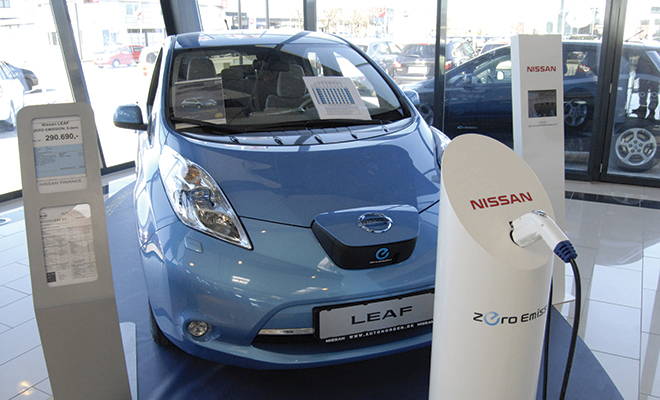
Plug In Instead of Fuel Up!
The Flocken Elektrowagen is said to have been the first electric car in the world. It was developed in 1888 by German inventor Andreas Flocken. And Thomas Edison, who actually invented not only the electric light bulb, but a battery for an electric car, would surely have one “plugged in” in his garage if he were alive today!
As of June 2016, the world’s top-selling electric car was the Nissan Leaf, which was released in December 2010, with more than 228,000 sold worldwide. Next comes the Tesla Model S, which was released in June 2012, with over 129,000 sold. That’s a lot of plugging in, and the response has been even better around the United States and the world in making sure there is plenty of electricity to go around.
In the simplest terms, these electric cars, or EVs, are powered entirely by an electric motor supplied by a large battery. They do not have gas engines as hybrids do, but they are fueled by plugging in and charging up.
And they are less expensive to operate. The U.S. Environmental Protection Agency estimates that an average all-electric car requires $3.74 worth of electricity to travel 100 miles. Compare that to $13.36, the average cost of driving that same distance in a conventional car. To annualize these numbers, if you drive 12,000 miles per year in a conventional car, you would average $1,603 in fuel costs, while an EV driver would pay just $449 for electricity. To clarify, it equals a savings of $1,154 per year.
Here’s more good news. According to their developers and enthusiasts, electric vehicles are inherently more efficient at turning energy into miles driven. Electric drivetrains are 75 percent more efficient than internal combustion engine, or ICE, drivetrains. The electric drivetrain competes well in terms of efficiency for many reasons, including heat losses and inertial losses of various kinds, but ICEs are also thermodynamic systems with efficiencies limited by the heat cycle under which they operate.
Improvements have been made in the efficiency of gas-powered cars, but they face fundamental limits. In contrast, a Nissan Leaf or a Chevy Volt can go about 40 miles on 11 kilowatt-hours, or kWh, of electricity, the energy equivalent of a third of a gallon of gasoline. With the national average cost per kWh for electricity at 12 cents, this performance translates to the equivalent of more than 120 miles per gallon.
Another positive? Prices are coming down for EVs, including the Nissan Leaf, the Mitsubishi MiEV and the Honda Fit EV. It is estimated that the price of batteries per kilowatt hour will decline and this will encourage automakers to cut prices even more.
Currently, range limits of 70 to 100 miles per charge are a big factor to consider, but city drivers, whose average daily driving needs might be less than 40 miles, are prime candidates for EV ownership. Long-range drivers can take a look at the 265-mile range Tesla Model S.
Be sure to check on tax credits awarded to you for purchasing an EV! Many states and local governments offer some form of incentive for this green purchase. And since battery-operated electric cars work with simplified powertrains, you don’t have to worry about engine lubrication, transmission fluid, spark plugs and the starter.
Charging stations are popping up everywhere, many at no cost at workplaces, campuses and retail areas. If you have solar energy at home, this amplifies the environmental benefits of an EV. And obviously, EVs reduce greenhouse gas emissions, which results in cleaner air.
Another awesome fact is that EVs can be powered by electricity produced from multiple energy sources. Electricity can come from wind, solar, hydroelectric power, nuclear, biofuel and fossil fuel sources including natural gas, oil and coal.
These sources are produced almost entirely within the United States from local natural resources. So electric vehicles have the potential to support our economy and reduce our dependence on imported oil.
If you’re concerned about the battery life upgrades, with fast-moving technology, or the potential high cost of purchasing a new battery, consider leasing. A number of manufacturers offer tempting lease options, particularly since the 2017models have been introduced and the dealers may have a glut of the previous year’s vehicles.
For home charging, a 220/240-volt outlet, equivalent to the connection for a clothes dryer, is needed, at a minimum. Experts say this may take up to 20 hours for a full charge. The alternative is to have a qualified electrician install a special charging station for the EV that can accelerate charging to five to seven hours. Keep in mind that if temperatures drop below 20 degrees, a bit of mileage range may be lost.
If you’re ready to begin a new, unique life without gasoline, you’re ready for an EV. Just be sure to do your homework! ■
Sources: cnbc.com, evobsession.com, greencarreports.com, huffingtonpost.com, hybridcars.com, kcpl.com, npr.org, popularmechanics.com, vroomgirls.com and wikipedia.com.







